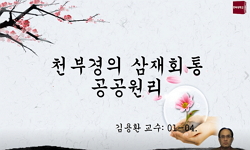정제두의 역도관(易圖觀)에서는 중국 역도학(易圖學)의 전통 즉 주돈이(周敦현?)의 태극도(太極圖)와 소옹(邵雍)의 선천학(先天學)을 기본 내용으로 역학(易學)적 사유의 성격과 특징을 보여...
http://chineseinput.net/에서 pinyin(병음)방식으로 중국어를 변환할 수 있습니다.
변환된 중국어를 복사하여 사용하시면 됩니다.
- 中文 을 입력하시려면 zhongwen을 입력하시고 space를누르시면됩니다.
- 北京 을 입력하시려면 beijing을 입력하시고 space를 누르시면 됩니다.

鄭齊斗의 易圖觀에 나타난 본체론적 사유방식 = The Thinking-way of Original-substantial Theory in Jeong-je-du's View of Zhouyi-diagram
한글로보기https://www.riss.kr/link?id=A76365578
- 저자
- 발행기관
- 학술지명
- 권호사항
-
발행연도
2005
-
작성언어
Korean
- 주제어
-
등재정보
KCI등재
-
자료형태
학술저널
- 발행기관 URL
-
수록면
109-134(26쪽)
- 제공처
-
0
상세조회 -
0
다운로드
부가정보
국문 초록 (Abstract)
정제두의 역도관(易圖觀)에서는 중국 역도학(易圖學)의 전통 즉 주돈이(周敦현?)의 태극도(太極圖)와 소옹(邵雍)의 선천학(先天學)을 기본 내용으로 역학(易學)적 사유의 성격과 특징을 보여준다. 정제두는 우주생성관 즉 무극(無極), 태극(太極), 음양(陰陽), 사상(四象), 오행(五行), 만물의 과정에서 사상과 오행의 본질적인 관계를 주목한다. 그리고 그는 정주학(程朱學)의 “체용일원(體用一源)”의 방식에 따라 그 본질적 관계로부터 본체론적인 사유를 이끌어낸다. 그의 본체론적 사유에서는 한대부터 전해져 온 괘기설(卦氣說)과는 달리, 태극을 기(氣)로 보지 않고 리(理)로 본다는 점에서 주희(朱熹)의 관점 즉 태극본체론(太極本體論)과 일치하고 있다. 또한 동정의 리(理)와 음양의 기(氣)를 구분한다는 점에서 양명학의 노선으로 귀결된다. 태극은 리로서 그 본원적 양상은 동과 정의 방식을 따르며, 그 유행에 있어서는 때에 따른 음과 양의 기로 드러나는 것이다. 이러한 본체론적 사유는 자신의 선천후천도설에서 발휘된다. 그는 왕기(王畿)의 선천학(先天學)의 맥락에서 복희(伏羲) 8괘방위도의 본질을 선천(先天)과 후천(後天)의 합일 혹은 융합에 있다고 본다. 결론적으로, 역학적 사유가 성리학에 방법론을 제공한다고 한다면, 정제두의 역도관은 바로 자신의 본체론적 사유를 표출한 방식이라 할 수 있다.
다국어 초록 (Multilingual Abstract)
The essay is focused upon Jeong-je-du's view of Zhouyi diagram. In it he attaches significance to the character and characteristics of the thinking way of Zhouyi, whose contents are Chinese traditional theories of Zhouyi, that is, Zhou-dun-yi's Diagra...
The essay is focused upon Jeong-je-du's view of Zhouyi diagram. In it he attaches significance to the character and characteristics of the thinking way of Zhouyi, whose contents are Chinese traditional theories of Zhouyi, that is, Zhou-dun-yi's Diagram of Supreme Ultimate and Shao-yong's doctrine of Antedate-heaven. He pays attention to the substantial relationship between Four Forms and Five modes in the cosmological view of universe, which is based upon a series of creative process, that is, Nothing Ultimate, Supreme Ultimate, Four Forms, Five modes and myriad things. Furthermore, he draws an ontological thinking way from that process according to the view of substance-function, especially the unitary unity of substance and function presented in the school of Cheng-zhu. His thinking way of ontology is identical with Zhu-xi's viewpoint, namely, the substantial doctrine of Supreme Ultimate, in that the Supreme Ultimate is regarded as Principle, not as Vital Force. It is different from the unitary doctrine of hexagram and vital forces in Han dynasty. And it results in the traditional line of Yang-ming's school, in that the principle of movement and stillness is different from the vital forces of yin and yang. The Supreme Ultimate, as the Principle, is in accordance with the way of movement and stillness in its origin, and is revealed as the vital forces of yin and yang timelily proceeding its stream. His thinking way of ontology, furthermore, makes a way in the diagrammatical doctrine of Antedate-heaven and Postdate-heaven. He concludes that, in the context of Wang-ji's viewpoint of Antedate-heaven, the diagram of Fu-xi's Eight Hexagram is focused upon the unity or identity of Antedate-heaven and Postdate-heaven. Consequently, if the thinking way of Zhouyi provides a methodology to Neo-Confucianism, then, it seems to me, Jeong-je-du's view of Zhouyi diagram is a way of revealing his thinking way of ontology.
목차 (Table of Contents)
- 【요약문】
- Ⅰ. 서론
- Ⅱ. 태극, 사상 및 오행
- Ⅲ. 동정과 음양의 체용관
- Ⅳ. 선천과 후천의 합일
- 【요약문】
- Ⅰ. 서론
- Ⅱ. 태극, 사상 및 오행
- Ⅲ. 동정과 음양의 체용관
- Ⅳ. 선천과 후천의 합일
- Ⅴ. 결론
- 참고문헌
- 〈Abstract〉
동일학술지(권/호) 다른 논문
-
- 한국양명학회
- 崔在穆(Choi Jae-Mok)
- 2005
- KCI등재
-
- 한국양명학회
- 한정길(Jeong-gil Han)
- 2005
- KCI등재
-
- 한국양명학회
- 김세서리아(Kim Seseoria)
- 2005
- KCI등재
-
- 한국양명학회
- 천병돈(Chun Byung-Don)
- 2005
- KCI등재




 KCI
KCI DBpia
DBpia






